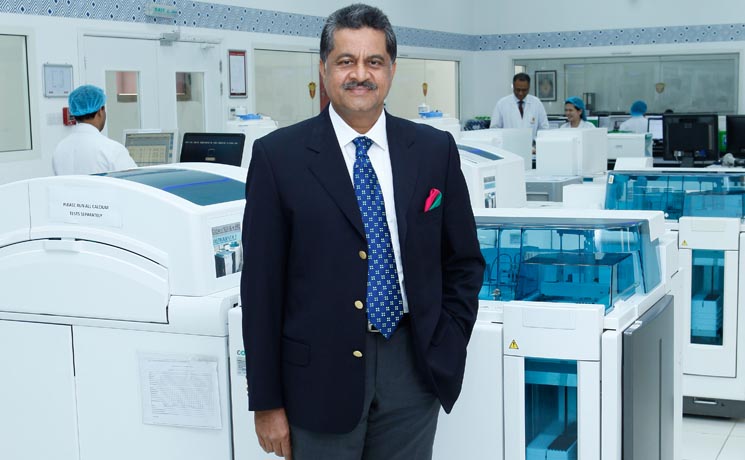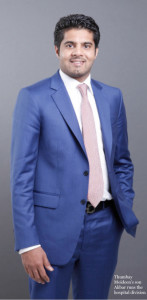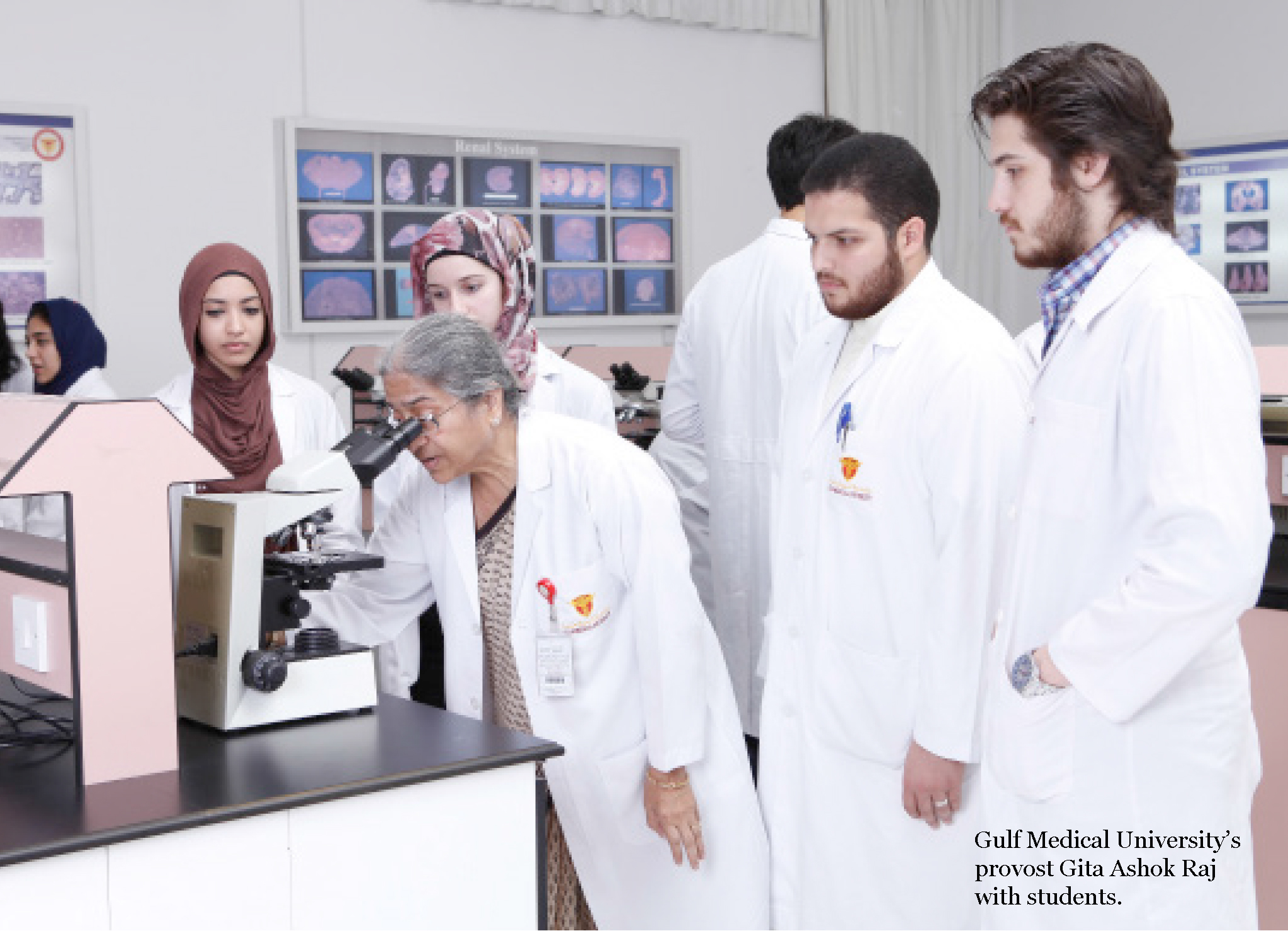Mangaluru, KARNATAKA / UNITED ARAB EMIRATES :
With the tinge of an Indian accent, a bespectacled professor rattled off medical terminology in English as students frantically took notes. Unfazed by the stench of embalming fluids, they examined the torso of a cadaver at Gulf Medical University (GMU) in Ajman, United Arab Emirates. Nothing unusual as far as anatomy classes go, except that GMU is the only privately owned academic medical center in the U.A.E. It is part of a network of four pioneering teaching hospitals that now train 19% of doctors in the country and treat nearly 1,800 patients a day.
The founder is Thumbay Moideen, a 58-year-old former timber trader from Mangalore, a port city on the Arabian Sea in southern India. He is as surprised as anyone to find himself at the helm of a growing healthcare empire, Thumbay Group, which generated $700 million last year, up more than 20% from 2014. “It’s an unlikely tale,” says Moideen.
The career switch has made Moideen a billionaire, with a fortune FORBES MIDDLE EAST estimates at $1.8 billion, based on comparable publicly traded healthcare companies in the U.A.E. He says he’s Thumbay Group’s sole shareholder.
What began as an institution to teach aspiring medical professionals from India in the U.A.E.—Indians make up half of the country’s population, turned into training grounds for all expats, and includes a sizeable Arab student body. The university gets up to 6,000 applications a year for a total of 270 spots. Tuition ranges from $8,000 a year for a degree in physiotherapy to $32,000 annually for a medical degree—more than three times the cost of an MD at a government-run university. Other specialties include dentistry and pharmacy. Since 2003, over 2,000 students have graduated.
Healthy Choice
The tale of Moideen’s ascent into medical academia begins in December 1997. Traveling from Mangalore to Tanzania, he made a stop in Ajman and paid a visit to a member of the royal family, Sheikh Majid bin Saeed Al Nuaimi, a family acquaintance.
Moideen was then working for his family’s timber and real estate company, BA Group Thumbay, a pillar of the Mangalore business community. His father, Ahmed Hajee Moideen, formed the establishment in 1957. It imports wood from Malaysia, Papua New Guinea, Tanzania, Nigeria and Ghana, and processes them in its factories. After graduating with a degree in commerce from St. Aloysius College in Mangalore, Moideen joined the business in 1979, and traveled frequently.
Over dinner that December evening in Ajman, Sheikh Al Nuaimi asked him, “Can you think of a project which could have multiple effects on the economy of Ajman?” recalls Moideen.
Ajman is the smallest emirate in the U.A.E., and the royal family was on the hunt for new projects to help boost its economy.
“In those days, Ajman was like a village. There was nothing,” says Moideen.
He proposed expanding the family business in Ajman, but the Sheikh pushed for new ideas. Moideen told him the story of a medical university and affiliated hospital close to his hometown. Kasturba Medical College in Manipal began accepting medical students in 1969, and it built Kasturba Hospital. “The whole town grew around the college and it became world renowned,” says Moideen. In 2015, an India Today/Nielsen survey ranked Kasturba Medical College one of the top 10 medical schools in India—a feat in a country with more than 280 medical colleges.
Moideen thought their conversation was casual brainstorming, but the Sheikh immediately saw potential. Three days later, he brought up the idea of an academic medical center for Ajman with the Emirate’s ruler, Sheikh Humaid bin Rashid Al Nuaimi, who asked to see Moideen. He told the Emir that although it was an exciting idea, he didn’t have expertise in education or healthcare. The Emir persisted. “As we spoke, the ruler said, ‘you look like a smart chap, why don’t you try it? I’ll help you,’” recalls Moideen..
“It was a risky move, but I’m an adventurous fellow,” he says. It didn’t take him long to abandon his career in the family company in 1998, and immerse himself in the business of healthcare. “I was rushing between India and Ajman. I couldn’t keep up anymore and this was so much more exciting.”
His first move was to seek advice from Kasturba Medical College. Consultants from the school helped him draw a feasibility study. The only other medical schools in 1998 in the U.A.E. were Dubai Medical College, which is only open to women, and government-owned Al Ain University.
The Ministry of Higher Education didn’t allow expats to own a license for educational institutions, but a royal decree soon waived that requirement in January 1998. Moideen bought 25 acres of land from the government the following month, bankrolling the venture with an initial investment of nearly $41 million in bank loans and his own capital. In March, he began building the university and by the fall of that year, it started accepting students.
To his surprise, the school hardly got any Indian applicants. Arabs and expats from countries such as the U.K. and Germany enrolled. Gulf Medical University, which had only recruited Indian staff, quickly had to hire personnel from other nationalities.
The student body is now made up of 36% Arabs, 32% Asians (including Indians, Pakistanis and Sri Lankans) and 22% Africans; the rest comes from Europe and the U.S. Gita Ashok Raj, a pathologist from Mangalore, oversees a faculty of 162 from 22 countries. Students straighten up when she walks down the university corridors. “We have fast evolved from a college offering one full-time program to a full-fledged university offering 15 full-time programs,” she says.
To build the school’s reputation, Moideen began raising its profile by sponsoring conferences with top medical schools, such as Johns Hopkins, Mayo Clinic and Hamburg University. “We took the initiative 17 years ago and contacted these big universities,” he says. Early on, for example, GMU organized a national conference on ophthalmology along with the U.A.E.’s Ministry of Health and Mayo Clinic. James Garrity, Chair and Professor of Ophthalmology at Mayo Clinic, delivered the keynote address. To date, the school has organized more than 275 national and international conferences.
The plan for a teaching hospital began in 2000. For the first two years, students were sent to Iranian Hospital in Dubai, while Moideen built the first 200-bed Thumbay Hospital in Ajman. Financed with $81 million in loans from Islamic banks and his money, it opened in 2002, a year before the first graduating class. He opened three other hospitals with 60 beds each in Fujairah in 2006 and Sharjah in 2011, and 150 beds in Dubai in 2015. His eldest son Akbar who studied hospital management at the SDA Bocconi School of Management in Milan, Italy, runs the hospital division.
GCC countries still struggle with a shortage of medical professionals. There are 1.5 physicians per 1,000 people, while hospital beds lag at 21 per 10,000 people, according to Colliers International, a global real estate consultancy firm.
One law hasn’t changed for Thumbay Group: its medical school graduates are required to complete a year of internship at a government-owned hospital. Besides Al Ain University, they now include the University of Sharjah, and Ras al-Khaimah Medical and Health Sciences University.
The majority of GMU students go on to specialize in areas such as cardiology, neurology, and dermatology; 22% are admitted to U.S. medical schools for further training.
The school’s academic record hasn’t necessarily translated into a preference for its physicians, or any U.A.E.-trained doctor for that matter. Saudi German Hospital in Dubai, for example, hires GMU graduates with three years of experience, but a western education still carries prestige. “Western-trained doctors are preferred by patients,” says Semira Dikbas, executive, International Patients Program at Saudi German Hospital. “Gulf Medical University is well recognized, but we cannot compare it with any other university in Europe, the U.S. or India.”
In an effort to gain prestige, Moideen started the first medical journal in the GCC. Launched in 2012, the Gulf Medical Journal is a peer-reviewed publication with an international advisory board that includes doctors from India, the U.K. and U.S. Researchers at Gulf Medical University are expected to publish two to three articles a year. The school spends close to $3 million a year on research, and faculty is regularly awarded external grants. Recently, for example, the World Health Organization provided a $10,000 grant to study at-risk relatives of patients with diabetes, which affects one in five people in the U.A.E.
The strategy is slowly paying off at Thumbay hospitals too. In 2013, they received accreditation from Joint Commission International, a U.S. non-profit organization. It bestows its highly coveted stamp of approval on hospitals that meet benchmarks for quality and safety.
Thumbay Group runs the only privately owned teaching hospitals in the U.A.E., but the number of hospitals is growing to meet demand. VPS Healthcare, HNC Hospitals and NMC Healthcare, to name a few, are expanding. Their founders are also Indian entrepreneurs, who have staked out a claim in the healthcare sector in the Gulf.
Moideen has now set his sights on Ghana where he expects to open a medical school by 2017. He inaugurated a hospital in Hyderabad in November 2015, and plans to build hospitals in Saudi Arabia, Qatar, Bombay and Bangalore next year.
source: http://www.forbesmiddleeast.com / Forbes Middle East / Home> Business / March 01st, 2016












